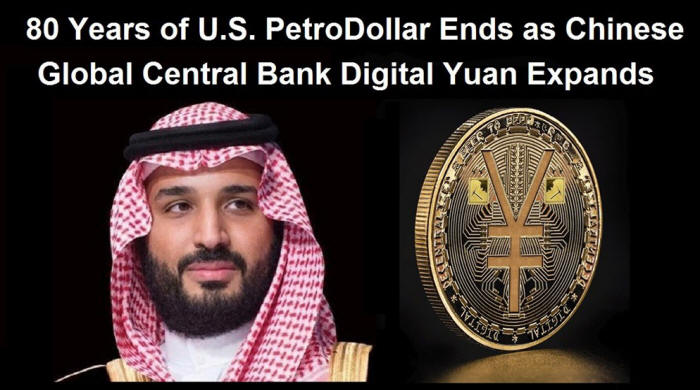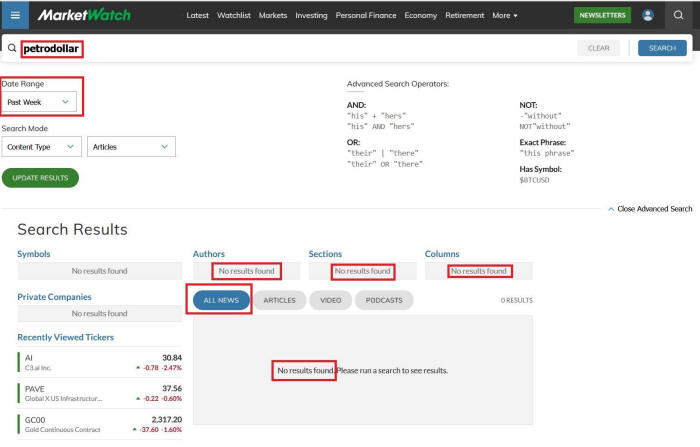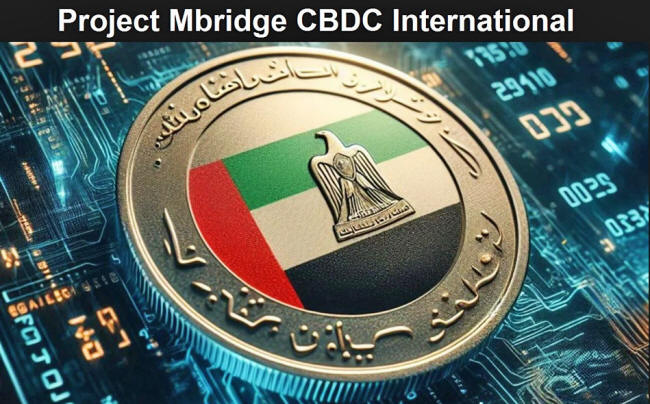|

by Brian Shilhavy
Editor, Health Impact News
June 13, 2024
from
VaccineImpact Website

This past Sunday (June 9, 2024) Saudi Arabia made the
historical move to not renew an 80-year-old agreement
with the United States that established the U.S. Dollar as the world
currency to purchase Saudi oil, in what should have been headline
news, but seems to have been blacklisted in U.S. financial news
publications, even in alternative financial news publications such
as ZeroHedge News.
Here is the coverage of this historic event from the The Business
Standard, a Bangladeshi daily newspaper.
Saudi Arabia's petro-dollar exit: A global
finance paradigm shift
The crucial decision to not renew the contract enables Saudi
Arabia to sell oil and other goods in multiple currencies,
including the,
...instead of exclusively in US dollars.
Significant financial upheaval is potentially ahead of the
financial world as Saudi Arabia has decided not to renew its
80-year petro-dollar deal with the United States.
The deal, which expired on Sunday 9 June, was a cornerstone of
the United States global economic dominance.
Originally signed on 8 June 1974, the deal established two joint
commissions, one based on economic cooperation and the other on
Saudi Arabia's military needs.
At the time, it was said that it heralded an era of close
cooperation between the two countries, says Katja Hamilton of
BizCommunity.
This latest development signifies a major shift away from the
petrodollar system established in 1972, when the US decoupled
its currency from gold, and is anticipated to hasten the global
shift away from the US dollar.
Source
While I could find no major U.S. English publication covering this
as headline news, there was plenty of discussion on Twitter/X.
One U.S. investor, Andrei Jikh, who has over 2 million subscribers
on YouTube, published a video on just what the end of the
petrodollar means, and that video has accumulated almost 1 million
views over the past couple of days.
The video is just over 15 minutes long, but the facts regarding the
end of the petrodollar is only covered in the first 12 minutes.
Everything after that is this investor's views, including his view
that people should continue investing in the U.S. Stock market and
also invest in Bitcoin, certainly a view that myself and many others
would not agree with.
But his summary of the history and significance of the Petrodollar
is excellent, and well worth the 12 minutes to watch.
The petrodollar agreement between Saudi Arabia and the United States
included more than just the agreement to require the purchase of oil
with U.S. dollars, as it also included a promise from the U.S. to
protect Saudi Arabia militarily, and also contained provisions for
establishing the State of Israel in 1948, something that President
Roosevelt actually opposed, but was adopted by his successor,
President Truman.
The Quincy Pact
Saudi Arabia reportedly did not renew "its 50-year petrodollar
agreement with the United States", an agreement that expired on
Sunday, June 9, 2024.
While it is permissible to doubt the existence of a
half-century-long agreement, it was indeed in 1974 that the
petrodollar emerged. Three short years after the end of the
Bretton Woods agreements.
From a historical perspective, the origins of the petrodollar
date back even to 1945.
On his way back from the Yalta conference, President Roosevelt
made a stop unbeknownst to the British along the Suez Canal. It
was aboard his cruiser USS Quincy that he met King Abdulaziz Al
Saud.
It will later be said that this meeting birthed the "Quincy
Pact."
This diplomatic anchorage went so well that Roosevelt offered
his wheelchair to the Saudi king, who was also disabled.
Despite this goodwill, the king refused to allow Jewish
settlement in Palestine.
However, the American president ensured the essential by
sidelining British Petroleum in favor of American oil companies.
This tacit agreement prevented the creation of a Jewish state,
but Roosevelt would die two months later. His successor, Harry
Truman, would be a strong supporter of the founding of Israel.
He would recognize the Hebrew state 11 minutes after the
Israelis declared themselves a nation, against the advice of his
Secretary of State.
Henry Kissinger's Masterstroke
It was in 1974 that the second historic meeting between the
Saudis and the American government took place. Henry Kissinger
had been Secretary of State for a year.
His mission?
To impose the dollar on the ingrates of
the old continent who dared to demand gold.
His strategy began with an intervention in
favor of Israel in the Yom Kippur War.
[For more context, note that Henry Kissinger is Jewish. He fled
Nazi Germany at the age of 15 and would return in uniform five
years later to fight in France and Germany.]
In retaliation, Arab countries ceased their oil exports,
primarily to European nations. The United States, for its part,
was self-sufficient. By 1974, the price of a barrel had
quadrupled, going from $3 to $12.
This oil embargo was all the easier to implement as the United
States had been pushing for years for the emancipation of Iraq,
Iran, Kuwait, the United Arab Emirates, Qatar, and Libya from
European companies (British Petroleum, Royal Dutch-Shell, and
the French Petroleum Company, ex-Total).
Kissinger wanted the price of the barrel to explode to weaken
the old continent. He knew well that the American army would
have the last word if things escalated, allowing him to impose
himself at the heart of international relations.
International discord would reach its peak when President Gerald
Ford recognized Jerusalem as the capital of the Hebrew state.
Petrodollar
In response, Saudi Arabia continued to raise the price of the
barrel, without knowing that it was playing into the hands of
Henry Kissinger, who would ultimately threaten to use force to
remedy what he called "the strangulation of the industrialized
world".
The London Sunday Times revealed in February
1975 the existence of the "Dhahran Option Four" plan, which
planned to invade Saudi Arabia to take possession of its oil
wells.
King Faisal would hear these drums of war very clearly.
At the end of 1974, he finally gave in to
Henry Kissinger's demands, who promised him the unlimited sale
of arms, a backpedal on the Jerusalem issue, and a return of
Israel to its 1948 borders (plus a myriad of technologies).
In exchange, Saudi Arabia had to:
1. Sell its oil exclusively in dollars.
2. Invest its dollar surpluses in American debt (It was
anyway impossible for a kingdom of 10 million inhabitants to
spend the thousands of billions of petrodollars).
All OPEC countries would agree in 1975 to
denominate their oil in dollars. Here are the broad lines of the
genesis of the petrodollar.
King Faisal would be assassinated on March
25, 1975, on the day of the Mawlid, the anniversary of the birth
of the prophet Muhammad.
Subsequently, Israel would never return to
its 1948 borders.
Source
I was amazed that this news of the petrodollar agreement ending
Sunday was barely mentioned, if mentioned at all, in the corporate
news in the U.S.
I subscribe to
Market Watch, a Dow Jones company, and a search I did
yesterday for any news on this petrodollar agreement ending this
past Sunday returned ZERO results.

However, I did find several articles in the corporate media from
recent days reporting that a new deal was expected soon between the
U.S. and Saudi Arabia.
Here is one based on an article published in the Wall Street
Journal.
US, Saudi Arabia close to finalizing draft
security treaty, WSJ reports
The Biden administration is close to finalizing a treaty with
Saudi Arabia that would commit the U.S. to help defend the Gulf
nation as part of a deal aimed at encouraging diplomatic ties
between Riyadh and Israel, the Wall Street Journal reported on
Sunday, citing U.S. and Saudi officials.
The possible deal, widely telegraphed by U.S. and other
officials for weeks, is part of a wider package that would
include a U.S.-Saudi civil nuclear pact, steps toward the
establishment of a Palestinian state and an end to the war in
Gaza, where months of ceasefire efforts have failed to bring
peace.
Approval of the treaty, which the WSJ said would be known as the
Strategic Alliance Agreement, would require a two-thirds
majority vote in the U.S. Senate, a threshold that would be
difficult to achieve unless the treaty were tied to
Israeli-Saudi normalization.
The draft treaty is modeled loosely on Washington's mutual
security pact with Japan, the newspaper cited U.S. and Saudi
officials as saying.
In exchange for the U.S. commitment to help defend Saudi Arabia
if it were attacked, the draft treaty would grant Washington
access to Saudi territory and airspace to protect U.S. interests
and regional partners, the newspaper reported.
It is also intended to bind Riyadh closer to Washington by
prohibiting China from building bases in the kingdom or pursuing
security cooperation with Riyadh, the WSJ quoted officials as
saying.
The White House, the U.S. State Department and the Saudi embassy
in Washington did not immediately respond to requests for
comment.
Source
And here is a contradictory article about a new U.S. - Saudi deal
published in The Atlantic from someone who actually went to Saudi
Arabia and interviewed people there.
The Saudi Deal the U.S. Actually Needs
Along-rumored deal to form a strategic partnership between the
United States and Saudi Arabia looks doomed to fail because of
Israel's inability to accept a path toward Palestinian statehood
in exchange for normalized ties with Saudi Arabia.
As the deal collapses, though, it is worth asking: What kind of
relationship should the United States and Saudi Arabia aspire
to? What is reasonable for each side to ask of the other?
On a recent trip to the kingdom, I spent a week speaking with
Saudis from various backgrounds: wealthy businessmen from the
eastern province, young Saudi women starting out in careers
unimaginable to their mothers, senior government officials
responsible for topics including privatization and foreign
policy, and young Saudi men doing everything from starting their
own law firm to driving for Uber after their government job had
ended for the day.
Beyond their usual warm hospitality, and their patience with my
rusty Arabic, I was struck by two things in conversations with
Saudis: First, it is hard not get caught up in the infectious
confidence they have about the direction their country is headed
in. They feel like they are building something new - and judging
by the innumerable construction cranes on Riyadh's skyline, they
are.
Second, there is deep frustration and even disillusionment with
the United States.
As a former government official, I am used to the regular
complaints, such as the tiresome allegations that the United
States is "abandoning" the region (despite the tens of thousands
of troops that continue to garrison the Persian Gulf).
But I heard newer, more disturbing concerns.
At dinner with a dozen or so older Saudi men one night - almost
all of whom had a degree from a U.S. university - I heard real
reservations about sending their children and grandchildren to
the United States to study: Gun violence, societal divisions,
and populist politics in America were all cited as reasons to
send their children to the United Kingdom or Europe instead.
One Saudi who had gotten his Ph.D. in the United States worried
that "the America I love is tearing itself apart at the seams."
And for what it's worth, I heard something very similar from a
group of businessmen in Singapore two weeks later.
Full article

The first cross-border digital
dirham payment was completed
by Sheikh
Mansour Bin Zayed Al Nahyan,
Chairman of the
Board of the Central Bank of the UAE,
using the
Mbridge platform, a
central bank
digital currency (CBDC) liquidity and interconnection tool.
The settlement
involved sending 50 million dirhams ($13.6 million)
directly to
China.
Source
While U.S. Bitcoin enthusiasts believe that Bitcoin can replace the
petrodollar, all the evidence points in the opposite direction, as
it was announced last week that Saudi Arabia has joined the Bank for
International Settlements (BIS) Project mBridge, a China-dominated
central bank digital currency.
Saudi Arabia Joins BIS and China-Led Central Bank Digital
Currency Project
LONDON (Reuters)
Saudi Arabia has joined a China-dominated
central bank digital currency cross-border trial, in what could
be another step towards less of the world's oil trade being done
in U.S. dollars.
The move, announced by the Bank for International Settlements on
Wednesday, will see Saudi's central bank become a "full
participant" of Project mBridge, a collaboration launched in
2021 between the central banks of China, Hong Kong, Thailand and
the United Arab Emirates.
The BIS, a global central bank umbrella organisation which
oversees the project, also announced that mBridge had reached
"minimum viable product" stage, meaning it will move beyond the
pro type phase.
Roughly 135 countries and currency unions, representing 98% of
global GDP, are exploring central bank digital currencies, or
CBDCs. But the new technologies they use makes cross-border
movement both technically challenging and politically sensitive.
"The most advanced cross-border CBDC project just added a major
G20 economy and the largest oil exporter in the world," said
Josh Lipsky, who runs a global CBDC tracker at the U.S.-based
Atlantic Council.
"This means in the coming year you can expect to see a scaling
up of commodity settlement on the platform outside of dollars -
something that was already underway between China and Saudi
Arabia but now has new technology behind it."
The mBridge transactions can use the code China's e-yuan is
built on.
Source
The U.S. Central Bank is not currently a part of mBridge, but one of
its branches is, the New York Federal Reserve.
The U.S. has been trying to broker a deal with Saudi Arabia that
includes recognition of a Palestinian state since Trump's Abraham
Accords proposal in 2020.
But the ongoing massacre of Palestinians has put any motivation by
Saudi Arabia to enter into new agreements with the U.S. on hold.
All the evidence points to Saudi Arabia
aligning more closely with China and Russia as they are now full
members of BRICS, and more evidence was seen this week when
Saudi Arabia's Crown Prince Mohammed bin Salman decided to skip
the G7 Summit currently going on in Italy.
Source
UPDATE:
And at the G7, Biden announced that the U.S. is
going to send more aid to Ukraine by seizing Russia's assets in U.S.
dollars in the U.S., which could have more disastrous repercussions
on the U.S. dollar.
Here is a short video by Dimitry Simes,
Jr. who explains what might happen next:
Saudi Arabia is also exporting more oil to China now, which is the
second largest economy in the world, and is an economy with a
net-negative oil balance, as they do not produce enough oil to meet
the consumption needs of China, whereas the U.S. now produces more
oil than the U.S. population consumes and is an oil exporter.
In recent news, it was announced that China is investing over $1
BILLION in natural gas pipelines in Saudi Arabia.
China's Sinopec to Build Gas Pipelines for
Saudi Aramco in $1-Billion Deal
A subsidiary of China's energy giant Sinopec has signed a
$1.3-billion deal with Saudi Aramco to procure and build
pipelines for an expansion of the Kingdom's natural gas
distribution network, the Chinese firm said on Thursday.
Under the turn-key fixed-price contract worth $1.3 billion (5.17
billion Saudi riyals), Sinopec International Petroleum Services
Corporation, a wholly-owned subsidiary of Sinopec Oilfield
Service Corporation, will be responsible for the in-country
procurement and construction of Packages 6 and 7 of the Phase 3
Pipeline Project Clusters of the Master Gas System.
Source
The
New World Order is rapidly changing right before our eyes.
If you only get your news from U.S. sources, where the U.S. only
makes up about 5% of the world's population, you are only getting
the minority view right now, and probably not seeing world events
the way the rest of the world is seeing them today...
|




